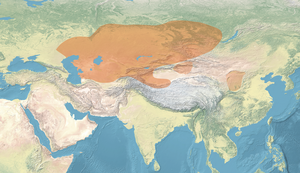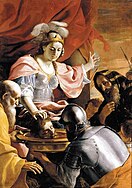Massagetae
Sakā tigraxauda Massagetae | |
|---|---|
| c. 8th century BCE–c. 3rd century BCE | |
| Common languages | Saka language |
| Religion | Scythian religion |
| Demonym(s) | Sakā tigraxaudā Orthocorybantes Massagetae |
| Government | Monarchy |
| King or Queen | |
•c. 530 BCE | Tomyris |
•c. 520 BCE | Skuⁿxa |
| Historical era | Iron AgeScythian cultures |
• Established | c. 8th century BCE |
• Disestablished | c. 3rd century BCE |
| Part ofa serieson |
| Indo-European topics |
|---|
 |
TheMassagetaeorMassageteans,also known asSakā tigraxaudāorOrthocorybantians,were anancientEastern IranianSakapeople[1][2][3][4][5]who inhabited thesteppesofCentral Asiaand were part of the widerScythian cultures.[6]The Massagetae rose to power in the 8th to 7th centuries BCE, when they started a series of events with wide-reaching consequences by expelling theScythiansout of Central Asia and into the Caucasian and Pontic Steppes. The Massagetae are most famous for their queenTomyris's alleged defeating and killing ofCyrus,the founder of thePersianAchaemenid Empire.[7]
The Massagetae declined after the 3rd century BCE, after which they merged with some other tribes to form theAlans,a people who belonged to the largerSarmatiantribal confederation, and who moved westwards into the Caucasian and European steppes, where they participated in the events of theMigration Period.[7]
Names[edit]
Massagetae[edit]
The nameMassagetaeis theLatinform of theAncient GreeknameΜασσαγεται(Massagetai).[2]
The IranologistRüdiger Schmittnotes that although the original name of the Massagetae is unattested, it appears that the most plausible etymon is theIranian*Masyaka-tā.[1][2]*Masyaka-tāis the plural form, containing theEast Iraniansuffix*-tā,which is reflected inGreek-tai.[2]The singular form is*Masi̯a-ka-and is composed of the Iranian*-ka-and*masi̯a-,meaning "fish," derived fromYoung Avestanmasiia-(𐬨𐬀𐬯𐬌𐬌𐬀;cognate withVedicmátsya-).[2]The name literally means "concerned with fish," or "fisherman."[1][2]This corresponds with the remark made by the ancient Greek historianHerodotus(1.216.3) that "they live on their livestock and fish."[1]Schmitt notes that objections to this reasoning, based on the assumption that, instead ofmasi̯a-,a derivation from Iranian*kapa-"fish" (compareOssetianкӕф(kæf)) would be expected, is "not decisive."[2]Schmitt states that any other interpretations on the origin of the original Iranian name of the Massagetae are "linguistically unacceptable."[2]
The IranologistJános Harmattahas, however, criticised the proposal ofMassagetai's derivation frommasyaka-ta,meaning "fish-eating (men)," as being semantically and phonologically unacceptable, and instead has suggested that the name might be derived from an earlyBactrian languagenameMaššagatā,from an earlierMašyagatārelated to theYoung Avestantermsmaṣ̌a-(𐬨𐬀𐬴𐬀),maṣ̌iia-(𐬨𐬀𐬴𐬌𐬌𐬀),maṣ̌iiāka-(𐬨𐬀𐬴𐬌𐬌𐬁𐬐𐬀), meaning "men," with the ending of the name being derived from theEast Iraniansuffix*-tāor from the collective formative syllable from which the suffix evolved. According to Harmatta's hypothesis, the Bactrian nameMaššagatāwould have corresponded to the nameDahā,meaning "men," used by the Massagetae for themselves.[8]
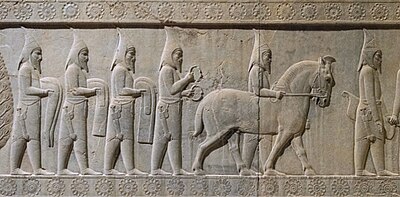
Sakā tigraxaudā[edit]
TheOld PersiannameSakā tigraxaudā(𐎿𐎣𐎠 𐏐 𐎫𐎡𐎥𐎼𐎧𐎢𐎭𐎠) meant "Sakawho wearpointed hats",[11]with the descriptivetigraxaudā(𐎫𐎡𐎥𐎼𐎧𐎢𐎭), meaning "wearer of pointed hats," being composed of the termstigraʰ(𐎫𐎡𐎥𐎼), "pointed," andxauda-(𐎧𐎢𐎭𐎠), "cap."[11]This name was a reference to thePhrygian capworn by the ancient Iranian peoples, of which theSakā tigraxaudāwore an unusually tall and pointed form.[12][13][14][15]
Orthocorybantes[edit]
The nameOrthocorybantiansgiven to theMassagetai/Sakā tigraxaudāis derived from theLatinnameOrthocorybantes,which is derived from theAncient Greek:Ορθοκορυβαντες,romanized:Orthokorubantes,which is itself the literal translation of theOld Persiannametigraxaudā(𐎫𐎡𐎥𐎼𐎧𐎢𐎭), meaning "wearer of pointed hats.",[16][17][18]
Apasiacae[edit]
The proposed etymologies for the Massagataean sub-tribe of the Apasiacae, whose name is not attested in ancient Iranian records, include*Āpasakā,meaning "Water-Sakas," and*Āpašyāka,meaning "rejoicing at water," which have so far not been conclusive.[19]
Identification[edit]

Sakā tigraxaudā[edit]
The IranologistJános Harmattahas identified the Massagetae as being the same as the people namedSakā tigraxaudā( “Sakāwho wearpointed caps”) by the Persians andOrthocorybantesbyGraeco-Romans.Harmatta's identification is based on the mention of theSakā tigraxaudāas living between theAmu DaryaandSyr Daryarivers, whereArrianalso located the Massagetae.[20]
The scholar Marek Jan Olbrycht has also identified the Massagetae with theSakā tigraxaudā.[7]
Dahā[edit]
János Harmatta has also identified theMassagetai/Sakā tigraxaudāwith theDahā,with this identification being based on the location of the former between theAmu DaryaandSyr Daryarivers, whereArrianalso located the Dahae.[21]The scholars A. Abetekov and H. Yusupov have also suggested that theDahāwere a constituent tribe of the Massagetae.[22]C. J. Brunner suggested that the Daha were either neighbours of the Saka Tigraxauda or that both groups were part of the same people.[23]
The scholar Y. A. Zadneprovskiy has instead suggested that the Dahae were descendants of the Massagetae.[24]
Marek Jan Olbrycht considers theDahāas being a separate group from the Saka, and therefore as not identical with the Massagetae/Sakā tigraxaudā.[25]
Sꜣg pḥ Sk tꜣ[edit]
Based onStrabo's remark that the Massagetae lived partly on the plains, the mountains, the marshes, and the islands in the country irrigated by the Araxes river, theIranologistRüdiger Schmitthas also suggestive a tentative connection with theSꜣg pḥ Sk tꜣ(Ancient Egyptian𓐠𓎼𓄖𓋴𓎝𓎡𓇿𓈉), the "Saka of the Marshes, Saka of the Land," mentioned in theSuez Inscriptions of Darius the Great.[2]
Sub-tribes[edit]
The Massagetae were composed of multiple sub-tribes, including:[26][27][2][28]
- theApasiacae(Ancient Greek:Απασιακαι,romanized:Apasiakai)
- theAugasii(Ancient Greek:Αυγασιοι,romanized:Augasioi)
- theDerbices(Ancient Greek:Δερβικες,romanized:Derbikes;Δερβικκαι,romanized:Derbikkai;Δερβεκιοι,romanized:Derbekioi[29])
Location[edit]
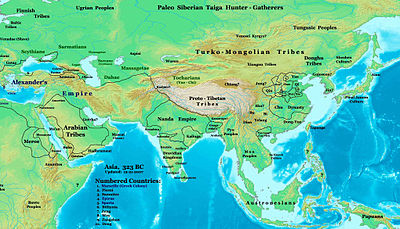
The Massagetae lived in the Caspian Steppe[7]as well as in the lowlands of Central Asia located to the east of theCaspian Seaand the south-east of theAral Sea,more precisely across the large area stretching from the lands around theAmu DaryaandZarafshanrivers up to the steppes and the deserts to the north of theKhorasanmountain corridor, that is in the region including theKyzylkumandKarakumdeserts and theUstyurt Plateau,especially the area between theOxusandIaxartesrivers[8][2][30]and aroundChorasmia.[31]The territory of the Massagetae thus included the area corresponding to modern-dayTurkmenistan[25]and might possibly have extended to parts ofHyrcaniaas well.[32][30]
One of the Massagetaean sub-groups, the Apasiacae, lived either on the east coast of theAral Seabetween theOxusandTanais/Iaxartesrivers, or possibly along the Oxus in westernBactria,[19]or between the Caspian and Aral Seas "[33][23]
Another Massagetaean sub-group, the Derbices, lived in the arid area to the north of theAtrekriver[23]bordered by theCaspian Seato the west, byHyrcaniato the south, the Oxus river in the east, and theBalkhan Mountainand theOchusriver and its estuary were in their territory.[23][34][35][36]During the Achaemenid period, some Derbices had migrated to the southwest along the shore of the Caspian Sea and reached centralTabaristan.The Derbices shared the region between the Caspian Sea and the Oxus with the Dahae,[23]who might however have been identical with the Massagetae,[8]and the Derbices might have extended to the east of the Oxus, with the Greek author Ctesias even extending their range up to the borders of Bactria and India.[23]
The imprecise description of where the Massagetae lived by ancient authors has however led modern scholars to ascribe to them various locations, such as theOxusdelta, the Iaxartes delta, between the Caspian and Aral seas or further to the north or north-east, but without basing these suggestions on any conclusive arguments.[2]
History[edit]
Early history[edit]
The Massagetae rose to power in the 8th to 7th centuries BCE, when they migrated from the east into Central Asia,[2]from where they expelled theScythians,another nomadic Iranian tribe to whom they were closely related. After this, they came to occupy large areas of the region, including the Caspian Steppe where they supplanted the Scythians.[7]The Massagetae displacing the early Scythians and forcing them to the west across theAraxesriver and into the Caucasian and Pontic steppes started a significant movement of the nomadic peoples of theEurasian Steppe,[37]following which the Scythians displaced theCimmeriansand theAgathyrsi,who were also nomadic Iranian peoples closely related to the Massagetae and the Scythians, conquered their territories,[37][38][7][39][40][41]and invadedWestern Asia.There, their presence had an important role in the history of the ancient civilisations ofMesopotamia,Anatolia,Egypt,andIran.[39]
TheSakā tigraxaudāhad close contact with theMedian Empire,whose influence had stretched to the lands east of theCaspian Sea,before it was replaced by the Persian Achaemenid dynasty in 550 BC.[42]
Death of Cyrus[edit]
During the 6th century BCE, the Massagetae had to face the successor of the Median Empire, the newly formedPersianAchaemenid Empire,whose founder,Cyrus II,carried out a campaign against them in 530 BCE.[2]According to Herodotus, Cyrus captured a Massagetaean camp by ruse, after which the Massagetae queenTomyrisled the tribe's main force against the Persians, defeated them, killed Cyrus, and placed his severed head in a sack full of blood.[43]According to another version of the death of Cyrus recorded byCtesias,it was the Derbices, who were the tribe against whom Cyrus died in battle: according to this version, he was mortally wounded by the Derbices and theirIndianallies, after which Cyrus's ally, the king Amorges of theSakā haumavargā,intervened with his own army and helped the Persian soldiers defeat the Derbices, following which Cyrus endured for three days, during which he organised his empire and appointedSpitacesson ofSisamasas satrap over the Derbices, before finally dying. The reason why the Derbices, and not the Massagetae, are named as the people against whom Cyrus died fighting is because the Derbices were members or identical with the Massagetae.[44][27][2][45]According toStrabo,Cyrus died fighting against theSaka(of which the Massagetae were a group), and according toQuintus Curtius Rufushe died fighting against theAbiae.[22]
TheBabylonianscribeBerossus,who lived in 3rd century BCE, instead recorded that Cyrus died in a battle against theDahae;according to the IranologistMuhammad Dandamayev,Berossus identified the Dahae rather than the Massagetae as Cyrus's killers because they had replaced the Massagetae as the most famous nomadic tribe of Central Asia long before Berossus's time;[27][28]although some scholars identified the Dahae as being identical with the Massagetae or as one of their sub-groups.[8][22][24]
Achaemenid rule[edit]

Little more is known about the Massagetae after the war with Cyrus. During the Achaemenid period, they were pressing on Hyrcania,[23]and by around 520 BCE and possibly earlier, they were ruled by a king namedSkuⁿxa,who rebelled against the Persian Empire until one of the successors of Cyrus, the Achaemenid kingDarius I,carried out a campaign against the Sakas from 520 to 518 BCE during which he conquered the Massagetae/Sakā tigraxaudā,captured Skuⁿxa, and replaced him with a ruler who was loyal to Achaemenid power.[2][45][46]According toPolyaenus,Darius fought against three armies led by three kings, respectively namedSacesphares,Thamyris(whose name might be related to that of Tomyris), andAmorgesorHomarges,with Polyaenus's account being based on Persian historical records.[45][47][48]
The territories of the Saka were absorbed into the Achaemenid Empire as part ofChorasmia,which included much of the territory between theOxusand theIaxartesrivers,[49]and the Saka supplied the Achaemenid army with a large number of mounted bowmen.[50]After Darius's administrative reforms of the Achaemenid Empire, theSakā tigraxaudāwere included within the same tax district as theMedes.[42]
During the Macedonian invasion of the Achaemenid Empire, the Massagetae provided the Achaemenid army with 40,000 troops, which was a larger number than the troops furnished by all the other inhabitants of the coast of the Caspian Sea put together.[23]
Later history[edit]
The Massagetae, along with the Sogdians and Bactrians, participated in the rebellion ofSpitamenesagainstAlexander III of Macedon,but they later submitted to him again after Spitamenes was murdered.[2]
Among the scholars who do not identify the Massagetae with the Dahae,Rüdiger Schmittsuggests that the Massagetae were instead absorbed by theDahaeby the laterHellenistic period.[2]Muhammad Dandamayevhas suggested that the Dahae had replaced the Massagetae as the most known people of the Central Asian steppes.[27][28]Marek Jan Olbrycht suggests that the Dahae migrated to the west from the areas east of the Aral Sea and around the Iaxartes valley and expelled the Derbices from their homeland, after which the latter split, with a part of them migrating into Hyrcania and others to the lowerUzboyriver.[51]
During the Hellenistic period, a section of the Massagetaean sub-tribe of the Derbices had migrated to the southwest along the coast of the Caspian Sea and reached centralTabaristan,while another sub-group moved to the south-east intoMargiana.[23]
Around 230 BCE, theParnianking and founder of theParthian Empire,Arsaces I,sought refuge from theSeleucidkingSeleucus II Callinicusby fleeing among the Massagataean sub-tribe of the Apasiacae.[19]Seleucus's attempted campaign to recover the eastern satrapies of his empire was initially successful. However, the outbreak of revolts in the western part of his empire prevented him from continuing his war against the Parthians, who, with the backing of the Apasiacae, were ultimately successful.[52]
Disappearance[edit]
The dominance of the Massagetae in Central Asia ended in the 3rd century BCE, following the Macedonianconquest of Persia,which cut off the relations between the steppe nomads and the sedentary populations of the previousPersianAchaemenid Empire.The succeedingSeleucid Empirestarted attacking the Massagetae,SakaandDahaenomads who had lived to the north of its borders, which in turn led to these peoples putting westward pressure from the east on a related nomadic Iranian people, the Sarmatians. The Sarmatians, taking advantage of the decline of Scythian power in the west, crossed the Don river and invadedScythiastarting in the late 4th century and the early 3rd century BCE.[53][7]
The Massagetae themselves merged with tribal groups in Central Asia to form theAlans,a people who themselves belonged to the largerSarmatiangroup. Related to theAsiiwho had invadedBactriain the 2nd century BCE, the Alans were pushed by theKang-chüpeople to the west into the Caucasian and Pontic steppes, where they came in contact and conflict with theParthianandRomanempires. By the 2nd century CE, they had conquered the steppes of the north Caucasus and the north Black Sea area and created a powerful confederation of tribes under their rule.[53][7]
In 375 CE, theHunsconquered most of the Alans living to the east of theDon river,massacred a significant number of them and absorbed them into their tribal polity, while the Alans to the west of the Don remained free from Hunnish domination and participated in the movements of theMigration Period.Some free Alans fled into the mountains of the Caucasus, where they participated in the ethnogenesis of populations including theOssetiansand theKabardians,and other Alan groupings survived inCrimea.Other free Alans migrated into Central and then Western Europe, from where some of them went toBritanniaandHispania,and some Alans joined theGermanicVandalsinto crossing theStrait of Gibraltarand creating theVandal KingdominNorth Africa.[7][53]
Legacy[edit]
Byzantineauthors later used the name "Massagetae" as an archaising term for theHuns,Turks,Tatarsand other related peoples who were completely unrelated to the populations the name initially designated in Antiquity.[2]
A 9th century work byRabanus Maurus,De Universo,states: "The Massagetae are in origin from the tribe of the Scythians, and are called Massagetae, as if heavy, that is, strong Getae."[54][55]In Central Asian languages such asMiddle PersianandAvestan,the prefixmassameans "great," "heavy," or "strong."[56]
Some authors, such asAlexander Cunningham,James P. Mallory,Victor H. Mair,andEdgar Knoblochhave proposed relating the Massagetae to theGutiansof 2000 BC Mesopotamia, and/or a people known in ancient China as the "DaYuezhi"or" Great Yuezhi "(who founded theKushan Empirein South Asia). Mallory and Mair suggest thatDa Yuezhimay at one time have been pronouncedd'ad-ngiwat-tieg,connecting them to the Massagetae.[57][58][59]These theories are not widely accepted, however.
Many scholars have suggested that the Massagetae were related to theGetaeof ancient Eastern Europe.[60]
Tadeusz Sulimirskinotes that theSacaealso invaded parts of Northern India.[61]Weer Rajendra Rishi,an Indian linguist[62]has identified linguistic affinities between Indian and Central Asian languages, which further lends credence to the possibility of historicalSacaeinfluence in Northern India.[56][61]
Culture[edit]
Lifestyle[edit]
According toStrabo,the Massagetae lived on the plains, the mountains, the marshes, and the islands in the country irrigated by the Araxes river.[2]
Some Massagetae were primarily fishermen, and other groups of the tribe bred sheep for their milk and wool, but also harvested root vegetables and wild fruits.[2]None of the Massagetae, however, practised any form of agriculture, and their food consisted of meat and fish, and they primarily drank milk, but not wine.[5]According to the Greek author Strabo, the Derbices did not consume any female animals.[23]
Gold and bronze were plentiful where the Massagetae lived, but they did not use any iron or silver because these were not available in their country.[5]
The Massagetae might possibly have practised cranial deformation.[23]
Clothing[edit]
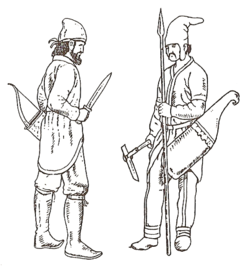
Tigraxaudā/Orthocorybantian soldier on the right wears a pointed hat.
Like all ancient Iranian peoples, the Massagetae/Sakā tigraxaudāwore knee-length tunics which were either straight and closed (following Median fashion) or open with lapels, both styles being fastened by a belt at the waist (following typically Scythic fashion). Underneath, they wore narrowtrousersandmoccasins.Over these, they sometimes wore a cloak with long and narrow sleeves, and thepointed cap,although their tribe wore a distinctive form of this headdress which had a sharp point, and from which the names given to them by the Persians (𐎫𐎡𐎥𐎼𐎧𐎢𐎭Tigraxaudā) and the Greeks (ΟρθοκορυβαντεςOrthokorubantes), both meaning "wearer ofpointed caps,"were derived. The use of the Median closed tunic among theSakā tigraxaudāwas the result of extensive contact between theTigraxaudāand the Medes during the period of the Median Empire.[14][12][63][16][64]
The fishermen wore seal skins, while the sheep-breeders wore clothing made of wool.[2]
The Massagetae wore golden headdresses, belts, shoulder straps, and used golden harnesses and bronze armour for their horses.[2]
Warfare[edit]
The Massagetae fought both on foot and on horseback, and their weapons consisted of bows and arrows, spears, and battle-axes, and their horse armour, spearheads, and arrowheads were golden.[2][5]
The Massagetae especially used spears whose blades were made of copper or iron, due to which the Greek called them theaikhmophoroi(αιχμοφοροι), meaning "spear-bearers."[65]
Language[edit]
The name of the Massagetaean prince, recorded in the Greek formSpargapisēs(Σπαργαπισης) and reflecting the Scythian form*Spargapis,is ofScythian languageorigin, and his name and the name of theAgathyrsikingSpargapeithesand the Scythian kingSpargapeithes(Scythian:*Spargapaiϑah) are variants of the same name, and are cognates with the Avestan nameSparəγa-paēsa(𐬯𐬞𐬀𐬭𐬆𐬖𐬀-𐬞𐬀𐬉𐬯𐬀).[66][67][2]
The name of theSakā tigraxaudākingSkuⁿxamight be related to theOssetianterm meaning "distinguishing oneself," and attested asskₒyxyn(схоыхын) in theDigordialect, and asæsk’wænxun(ӕскъуӕнхун) in theIrondialect.[68][69]
Religion[edit]
Herodotus mentioned that the Massagetae worshipped only the sun god, to whom they sacrificed horses. This is seen to indicate the cult of the Iranian sun godMithra,who was associated with the worship of fire and horses.[2][22]When Cyrus attacked the Massagetae, their queen Tomyris swore by the Sun to kill him if he did not return to his kingdom.[5]
However,Straborecorded that the Derbices, who were either identical with the Massagetae or one of their sub-tribes, worshipped "Mother Earth," interpreted as the Earth and Water goddessApi.[70]
Marriage customs[edit]
The Massagetae contracted monogamous marriages, although the wives could have sexual relations with other men. When a Massagetaean man wanted to have sexual relations with a woman, he would hang hisgorytosoutside of her tent, inside of which the couple would proceed to have intercourse.[2][5]Edvard Westermarck,however, inThe History of Human Marriage,suggested that Herodotus and Strabo, on whose writings this understanding of Massagetaean marriage customs is based, might have been mistaken, and that the relevant custom was instead one, said to be common in Central Asia, by which brothers shared a single wife.[71]
Funeral customs[edit]
According to Herodotus, members of the Massagetae were sacrificed and cooked and eaten with the meat of sacrificial animals. Members of the Massagetae who died of illness were buried or left as food for wild animals.[2]
See also[edit]
- Zarinaea,queen of a Saka tribe which also had contact with the Medes
- Mount Imeon
- Indo-Scythians
- Getae
- Thyssagetae
Footnotes[edit]
- ^abcdSchmitt 2021.
- ^abcdefghijklmnopqrstuvwxyzaaabSchmitt 2018a.
- ^Diakonoff 1985.
- ^Grousset 1970,p.547.
- ^abcdefGera 2018.
- ^Unterländer 2017:"During the first millennium BCE, nomadic people spread over the Eurasian Steppe from the Altai Mountains over the northern Black Sea area as far as the Carpathian Basin... Greek and Persian historians of the 1st millennium BCE chronicle the existence of the Massagetae and Sauromatians, and later, the Sarmatians and Sacae: cultures possessing artefacts similar to those found in classical Scythian monuments, such as weapons, horse harnesses and a distinctive ‘Animal Style' artistic tradition. Accordingly, these groups are often assigned to the Scythian culture..."
- ^abcdefghiOlbrycht 2000.
- ^abcdHarmatta 1999.
- ^Verlang von D. Reimer (1982).Archäologische Mitteilungen aus Iran.pp. 223–225.
- ^Sandes 2014.
- ^abSummerer 2007,p. 19-20.
- ^abDandamayev 1994,p. 45.
- ^Negmatov 1994,p. 443-444.
- ^abFrancfort 1988,pp. 189–191.
- ^Vogelsang 1992,p. 156-157.
- ^abDiakonoff 1985,p. 100: As for the term “Orthocorybantii”, this is a translation of Iraniantigraxauda-“wearers of pointed caps”
- ^Dandamayev 1994:"TheSakā Tigraxaudā(who wear pointed caps) were known to Greek authors as theOrthokorybantioi,a direct translation of the Old Persian name "
- ^Lendering 1996:"Herodotus calls the Sakâ tigrakhaudâ theOrthocorybantians( "pointed hat men" ) "
- ^abcSchmitt 1986.
- ^Harmatta 1999:However, we must not forget that the Old Persian epigraphic texts distinguish for Saka tribes or peoples: 1.Sakā tayaiy paradraya"Sakas who are living beyond the sea" (=European Scythians). 2.Sakā haumavargā"Sakas worshipping the Hauma" (in Central Asia, theἈμύργιοι Σάκαιof the Greek geographers), 3.Sakā tigraxaudā"Sakas who wear the pointed cap" (between theAraxša= Amu darya and the Sir-darya rivers, 4.Sakā tayaiy para Sugdam"Sakas who are living beyond Sogdiana (=beyond the Sir-darya river)"
---------------------------------------------------------------------------
In the quoted passage, however, Arrian says that these Scythians, living in the neighbourhood of the Sogdians between the Amu-darya and the Sir-darya rivers, were calledMassagetae.Consequently, the nameΜασσαγέταιmay be the individual denomination, the proper name of this Iranian nomadic people. - ^Harmatta 1999:In the quoted passage, however, Arrian says that these Scythians, living in the neighbourhood of the Sogdians between the Amu-darya and the Sir-darya rivers, were calledMassagetae.Consequently, the nameΜασσαγέταιmay be the individual denomination, the proper name of this Iranian nomadic people. But a clear judgement in this matter is impeded by the fact that Arrian (III. 28, 8) describes theDahae(Δάαι) as living on this side of the Tanais = Sir-darya, i.e. between the Sir-darya and Amu-darya rivers. From this report it follows that the Massagetae were identical with the Dahae.
- ^abcdAbetekov & Yusupov 1994.
- ^abcdefghijkBrunner 2004.
- ^abZadneprovskiy 1994:"The middle of the third century b.c. saw the rise to power of a group of tribes consisting of the Parni (Aparni) and the Dahae, descendants of the Massagetae of the Aral Sea region."
- ^abOlbrycht 2021,p. 22: "Apparently the Dahai represented an entity not identical with the other better known groups of the Sakai, i.e. the Sakai (Sakā) tigrakhaudā (Massagetai, roaming in Turkmenistan), and Sakai (Sakā) Haumavargā (in Transoxania and beyond the Syr Daryā)."
- ^Olbrycht 2021,p. 21.
- ^abcdDandamayev 1994.
- ^abcDandamayev 1989,p. 67.
- ^Smith, William(1854).The Dictionary of Greek and Roman Geography.Bostin:Little, Brown and Company.p.Derbiccae.
- ^abVogelsang 1992,p. 160: "In section 2 theDahâof the XPh were provisionally located among the confines of the Karakum desert. This leads us again to the problem of theSakâ Tigraxaudâ,whom we located in much of the same area, namely in the steppes east of the Caspian and who are distinguished by a combination of Medic and Scythic features. "
- ^Francfort 1988,p. 184.
- ^Vogelsang 1992,p. 132: "It may thus be hypotesized that theSakâ Tigraxaudâinhabited an area that covered (some of) the lands among the Amu Daryâ and the Zarafshân. They may even have inhabited ancientVarkâna,since the Behistun text does not mention any campaigns in that area, in spite of the fact thatVarkânais listed as one of the rebellious lands. With hostileSakâ Tigraxaudâinhabiting the deserts and steppes of the lands north of the Khurâsân desert corridor,... "
- ^Cook 1985:"the Pausikai could be the same as the Apsiakai of Polybius and Strabo between the Oxus and the Jaxartes." }}
- ^Olbrycht 2021,p. 33-34.
- ^Olbrycht 2021,p. 116.
- ^Olbrycht 2021,p. 293.
- ^abSulimirski & Taylor 1991,p. 553.
- ^Harmatta 1996.
- ^abSulimirski & Taylor 1991,p. 560-590.
- ^Batty 2007,p. 202-203.
- ^Sulimirski 1985.
- ^abVogelsang 1992,p. 160.
- ^Herodotus(1975). G.P. Goold (ed.).Herodotus: The Persian Wars.Vol. 1 (Books I–II). Translated by A.D. Godley. Cambridge, Massachusetts; London: Harvard University Press; William Heinemann Ltd. p.269(Book I).ISBN0-674-99130-3.(ISBN0-434-99117-1- British)
- ^Francfort 1988,p. 171.
- ^abcSchmitt 1994.
- ^Shahbazi 1994.
- ^Vogelsang 1992,p. 131.
- ^De Jong 1997,p.297.
- ^Cunliffe 2015,p.235.
- ^Dandamayev 1994,pp. 44–46
- ^Olbrycht 2021,p. 32-34.
- ^Koshelenko & Pilipko 1994.
- ^abcMelyukova 1990.
- ^Maurus, Rabanus(1864). Migne, Jacques Paul (ed.).De universo.Paris.
The Massagetae are in origin from the tribe of theScythians,and are called Massagetae, as if heavy, that is, strong Getae.
{{cite book}}:CS1 maint: location missing publisher (link) - ^Dhillon, Balbir Singh (1994).History and study of the Jats: with reference to Sikhs, Scythians, Alans, Sarmatians, Goths, and Jutes(illustrated ed.). Canada: Beta Publishers. p. 8.ISBN1-895603-02-1.
- ^abRishi, Weer Rajendra(1982).India & Russia: linguistic & cultural affinity.Roma. p. 95.
- ^Mallory, J. P.; Mair, Victor H. (2000).The Tarim Mummies: Ancient China and the Mystery of the Earliest Peoples from the West.London: Thames & Hudson. pp. 98–99.ISBN0-500-05101-1.
- ^John F. Haskins (2016).Pazyrik – The Valley of the Frozen Tombs.Read Books. p. 10.ISBN978-1-4733-5279-7.
- ^THE STRONGEST TRIBE, Yu. A. Zuev, page 33: "Massagets of the earliest ancient authors... are the Yuezhis of the Chinese sources"
- ^Leake, Jane Acomb (1967).The Geats of Beowulf: a study in the geographical mythology of the Middle Ages(illustrated ed.). University of Wisconsin Press. p. 68.ISBN978-0-598-17720-9.
- ^abSulimirski, Tadeusz(1970).The Sarmatians.Vol. 73 of Ancient peoples and places. New York: Praeger. pp. 113–114.ISBN9789080057272.
The evidence of both the ancient authors and the archaeological remains point to a massive migration of Sacian (Sakas)/Massagetan tribes from the Syr Daria Delta (Central Asia) by the middle of the second century B.C. Some of the Syr Darian tribes; they also invaded North India.
- ^Indian Institute of Romani StudiesArchived2013-01-08 atarchive.today
- ^Negmatov 1994,p. 435.
- ^Vogelsang 1992,p. 156-157, 160.
- ^Litvinsky 2000.
- ^Hinz, Walther (1975).Altiranisches Sprachgut der Nebenüberlieferungen.Wiesbaden,Germany:Harrassowitz Verlag.p.226.ISBN978-3-447-01703-9.
- ^Kullanda 2014.
- ^Schmitt 2018a:"OPers.Skunxa-(the leader of the Sakas, who rebelled against Darius I), perhaps related to Oss.skₒyxyn/æsk’wænxun“to distinguish oneself”. "
- ^Schmitt 2018c:"3. altpers. Skunxa- (der Anführer der Saken, die sich gegen Dareios I. erhoben), vielleicht zu verbinden mit osset. digoron skₒyxyn, iron æsk'wænxun „sich auszeichnen usw.". "[3. OPers. Skunxa- (the leader of the Sakas, who rebelled against Darius I), perhaps related to Osset. Digorskₒyxyn, Iron æsk’wænxun"to distinguish oneself, etc.".]
- ^Safaee, Yazdan (2020)."Scythian and Zoroastrian Earth Goddesses: A Comparative Study on Api and Ārmaiti".In Niknami, Kamal-Aldin; Hozhabri, Ali (eds.).Archaeology of Iran in the Historical Period.University of Tehran Science and Humanities Series. Springer International Publishing. pp. 65–75.doi:10.1007/978-3-030-41776-5_6.ISBN978-3-030-41776-5.S2CID219515548.
- ^Westermarck, Edvard,The History of Human Marriage,Vol. 1, Ch. 3, pp.106-07 (London, 1921).
Sources[edit]
- "The Origin And Deeds Of The Goths".ucalgary.ca. 1997-04-22.Retrieved2010-05-14.
- Halsall, Paul (August 1998)."Herodotus: Queen Tomyris of the Massagetai and the Defeat of the Persians under Cyrus".Internet Ancient History Sourcebook.Retrieved2010-05-14.
- "More Women Rulers".Women in World History Curriculum. 1996–2010.Retrieved2010-05-14.
- Robert B. Strassler (2009).The Landmark Herodotus: The Histories.Random House Digital, Inc. pp. 113–4.ISBN9781400031146.
- Abetekov, A.[in Kyrgyz];Yusupov, H. (1994). "Ancient Iranian Nomads in Western Central Asia". InDani, Ahmad Hasan;Harmatta, János;Puri, Baij Nath;Etemadi, G. F.;Bosworth, Clifford Edmund(eds.).History of Civilizations of Central Asia.Paris,France:UNESCO.pp. 24–34.ISBN978-9-231-02846-5.
- Batty, Roger(2007).Rome and the Nomads: The Pontic-Danubian Realm in Antiquity.Oxford:Oxford University Press.ISBN978-0-198-14936-1.
- Cook, J. M.(1985). "The Rise of the Achaemenids and Establishment of Their Empire". InGershevitch, Ilya(ed.).The Cambridge History of Iran.Vol. 2.Cambridge,United Kingdom:Cambridge University Press.ISBN978-0-521-20091-2.
- Cunliffe, Barry(2015).By Steppe, Desert, and Ocean: The Birth of Eurasia.Oxford,United Kingdom:Oxford University Press.ISBN978-0-19-968917-0.
- Dandamayev, M. A.(1994). "Media and Achaemenid Iran". InDani, Ahmad Hasan;Harmatta, János;Puri, Baij Nath;Etemadi, G. F.;Bosworth, Clifford Edmund(eds.).The Development of Sedentary and Nomadic Civilizations: 700 B.C. to A.D. 250.History of Civilizations of Central Asia. Vol. 2.Paris,France:UNESCO.pp. 35–64.ISBN978-9-231-02846-5.
- Dandamayev, M. A.(1989).A Political History of the Achaemenid Empire.Leiden,Netherlands;New York City,United States:Brill.ISBN978-9-004-09172-6.
- De Jong, Albert(1997).Traditions of the Magi: Zoroastrianism in Greek and Latin Literature.Leiden,Netherlands;New York City,United States:BRILL.ISBN978-9-004-10844-8.
- Diakonoff, I. M.(1985). "Media". InGershevitch, Ilya(ed.).The Cambridge History of Iran.Vol. 2.Cambridge,United Kingdom:Cambridge University Press.pp. 36–148.ISBN978-0-521-20091-2.
- Francfort, Henri-Paul(1988). "Central Asia and Eastern Iran". InBoardman, John;Hammond, N. G. L.;Lewis, D. M.;Ostwald, M.(eds.).The Cambridge Ancient History.Vol. 4.Cambridge,United Kingdom:Cambridge University Press.ISBN978-0-521-22804-6.
- Gera, Deborah Levine (2018).Warrior Women: The Anonymous Tractatus De Mulieribus.Leiden,Netherlands;New York City,United States:Brill.pp. 187–199.ISBN978-9-004-32988-1.
- Grousset, René(1970).The Empire of the Steppes: A History of Central Asia.New Brunswick,United States:Rutgers University Press.ISBN978-0-813-51304-1.
- Harmatta, János(1996). "10.4.1. The Scythians". In Hermann, Joachim; de Laet, Sigfried (eds.).History of Humanity.Vol. 3.UNESCO.p. 181.ISBN978-9-231-02812-0.
- Harmatta, János (1999)."Alexander the Great in Central Asia".Acta Antiqua Academiae Scientiarum Hungaricae.39(1–4): 129–136.doi:10.1556/aant.39.1999.1-4.11.S2CID162246561.RetrievedJuly 4,2022.
- Kullanda, Sergey Vsevolodovich[in Russian](2014)."External Relations of Scythian".Journal of Language Relationship.11(1): 81–90.doi:10.31826/jlr-2014-110110.
- Lendering, Jona(1996)."Scythians / Sacae".Livius.org.Retrieved2022-07-08.
- Litvinsky, Boris A.[in Russian](2000)."Spear".Encyclopædia Iranica.New York City,United States:Encyclopædia Iranica Foundation;Brill Publishers.Retrieved11 May2023.
- Brunner, C. J. (2004)."Iran".Encyclopædia Iranica.Vol. 5.New York City,United States:Encyclopædia Iranica Foundation;Brill Publishers.Retrieved11 May2023.
- Koshelenko, G. A.; Pilipko, V. N. (1994). "Parthia". InDani, Ahmad Hasan;Harmatta, János;Puri, Baij Nath;Etemadi, G. F.;Bosworth, Clifford Edmund(eds.).History of Civilizations of Central Asia.Vol. 2.Paris,France:UNESCO.pp. 127–145.ISBN978-9-231-02846-5.
- Negmatov, N. N. (1994). "States in North-West Central Asia". InHarmatta, János(ed.).History of Civilizations of Central Asia.Vol. 2.UNESCO.pp. 432–447.ISBN9231028464.
- Olbrycht, Marek Jan (2021).Early Arsakid Parthia (ca. 250-165 B.C.): At the Crossroads of Iranian, Hellenistic, and Central Asian History.Leiden,Netherlands;Boston,United States:Brill.ISBN978-9-004-46076-8.
- Olbrycht, Marek Jan (2000)."Remarks on the Presence of Iranian Peoples in Europe and Their Asiatic Relations".InPstrusińska, Jadwiga[in Polish];Fear, Andrew (eds.).Collectanea Celto-Asiatica Cracoviensia.Kraków:Księgarnia Akademicka.pp. 101–140.ISBN978-8-371-88337-8.
- Melyukova, A. I.(1990).Sinor, Denis(ed.).The Cambridge History of Early Inner Asia.Vol. 1. Translated by Crookenden, Julia.Cambridge,United Kingdom;New York City,United States:Cambridge University Press.pp. 97–117.ISBN978-0-521-24304-9.
- Sandes, Caroline (2014)."Persepolis, Iran".Stanfords Blog.Stanfords.Retrieved14 January2018.
- Schmitt, R.(1994)."Amorges".Encyclopædia Iranica.New York City,United States:Encyclopædia Iranica Foundation;Brill Publishers.Retrieved2022-07-12.
- Schmitt, R.(2018a)."Scythian Language".Encyclopædia Iranica.New York City,United States:Encyclopædia Iranica Foundation;Brill Publishers.Retrieved28 July2022.
- Schmitt, R.(2018b)."Massagetae".Encyclopædia Iranica.New York City,United States:Encyclopædia Iranica Foundation;Brill Publishers.
- Schmitt, Rüdiger(2018c)."Die Sprache der Skythen"[THE LANGUAGE OF THE SCYTHIANS](PDF).Nartamongæ. The Journal of Alano-Ossetic Studies: Epic, Mythology & Language(in German).13(1–2): 77–86.doi:10.23671/VNC.2018.1-2.37869.ISSN1810-8172.Retrieved28 July2022.
- Schmitt, Rüdiger(2021)."Massagetae".Encyclopaedia of Islam.Brill Publishers.
- Schmitt, R.(1986). "3".Apasiacae.Encyclopædia Iranica.New York City,United States:Encyclopædia Iranica Foundation;Brill Publishers.Retrieved14 July2022.
- Shahbazi, A. Shapur(1994). "3".Darius.Encyclopædia Iranica.New York City,United States:Encyclopædia Iranica Foundation;Brill Publishers.Retrieved2022-07-12.
- Sulimirski, T.(1985). "The Scyths". InGershevitch, I.(ed.).The Cambridge History of Iran: The Median and Achaemenian Periods.Vol. 2.Cambridge University Press.pp. 149–199.ISBN978-1-139-05493-5.
- Sulimirski, Tadeusz;Taylor, T. F.(1991). "The Scythians". InBoardman, John;Edwards, I. E. S.;Hammond, N. G. L.;Sollberger, E.;Walker, C. B. F. (eds.).The Cambridge Ancient History.Vol. 3.Cambridge:Cambridge University Press.pp. 547–590.ISBN978-1-139-05429-4.
- Summerer, Lâtife (2007).Ivantchik, Askold;Licheli, Vakhtang (eds.).Achaemenid Culture and Local traditions in Anatolia, Southern Caucasus and Iran: New Discoveries.Brill Publishers.pp. 3–30.ISBN978-9-047-42398-0.
- Unterländer, Martina (2017)."Ancestry and demography and descendants of Iron Age nomads of the Eurasian Steppe".Nature Communications.8(1): 14615.Bibcode:2017NatCo...814615U.doi:10.1038/ncomms14615.PMC5337992.PMID28256537.
- Vogelsang, W. J.(1992).The Rise and Organisation of the Achaemenid Empire: The Eastern Iranian Evidence.Leiden,Netherlands;New York City,United States:Brill.ISBN978-9-004-09682-0.
- Zadneprovskiy, Y. A. (1994). "The Nomads of Northern Central Asia After the Invansion of Alexander". InDani, Ahmad Hasan;Harmatta, János;Puri, Baij Nath;Etemadi, G. F.;Bosworth, Clifford Edmund(eds.).History of Civilizations of Central Asia.Paris,France:UNESCO.pp. 448–463.ISBN978-9-231-02846-5.


